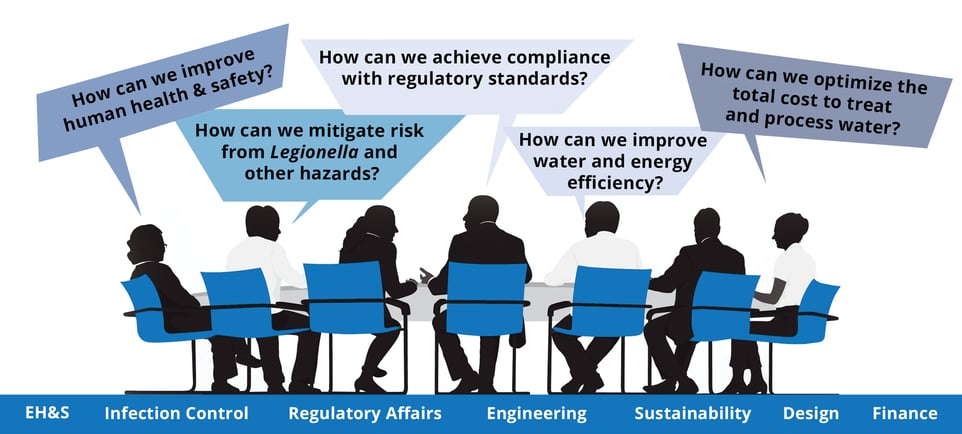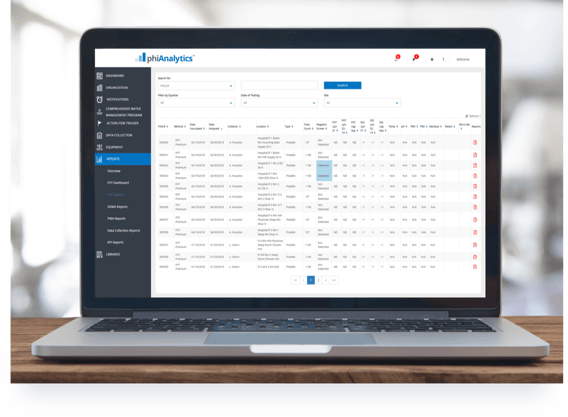 I’m pleased to announce the release of phiAnalytics™, our advanced, state-of-the-art information management system designed to help you achieve compliance with water safety standards and strengthen the defensibility of your organization’s water management program.
I’m pleased to announce the release of phiAnalytics™, our advanced, state-of-the-art information management system designed to help you achieve compliance with water safety standards and strengthen the defensibility of your organization’s water management program.
The innovative people at Phigenics in our Information Technology, Research and Sales Support groups have developed a  comprehensive, cloud-based software platform, which is built-to-scale using industry-leading best practices. It centralizes all aspects of your water management program onto an easy-to-use, highly secure website, thus providing more efficient documentation of defensible, sustainable, safe and cost-effective water use in your facilities.
comprehensive, cloud-based software platform, which is built-to-scale using industry-leading best practices. It centralizes all aspects of your water management program onto an easy-to-use, highly secure website, thus providing more efficient documentation of defensible, sustainable, safe and cost-effective water use in your facilities.
Outbreaks of Legionnaires’ disease and the resulting lawsuits have become more frequently reported from coast to coast. Local, state and federal agencies are publishing and enforcing more standards and regulations to specify building water system best management practices (ref: ASHRAE Std 188-2018, CMS S&C 17-30, CDC Toolkit, NY State Cooling Tower requirements).
As building owners and facility managers, you bear the responsibility of ensuring that your buildings are safe. This responsibility includes the safe and efficient management of water systems in your facility. You can accomplish this objective by implementing water management programs that prevent harm to the public while also conserving water and energy.
Legionella and other waterborne disease-causing bacteria such as Mycobacterium and Pseudomonas may thrive in common plumbing fixtures and water system devices such as showers, faucets, cooling towers, hot tubs, decorative fountains, water features and hot water tanks. Because the bacteria may be present throughout the water systems and devices in your building, you must be vigilant in combating these significant health hazards.
.png?width=962&name=Phigenics%20-%20Water%20Systems-horiztonal%20(1).png)
The cornerstone of successful water management for buildings is the cross-functional water management team (WMT). The WMT must make defensible decisions based on documented confirmation that their program has been implemented according to plan (verification data) and documented confirmation that control of waterborne pathogens has been achieved (validation data).

Keeping information for the WMT organized, easily retrievable and up-to-date is essential. Doing this efficiently will empower your WMT to make defensible decisions about the water systems for which they are responsible.
phiAnalytics was developed from its predecessor, phiMetrics. The phiMetrics system has served the needs of our clients well. However, new water-related standards have emerged with extensive documentation and data management requirements. Therefore, a more comprehensive and efficient information management system is necessary. phiAnalytics meets this need.
phiAnalytics™ empowers WMTs to collaborate, document, verify and validate.

For any facility manager, and particularly for those managing large enterprise systems, collaboration can be a challenge. The organizational and site management features in phiAnalytics scale to accommodate facility managers with single buildings all the way up to enterprise organization managers who are responsible for tens or hundreds of buildings. phiAnalytics more efficiently enables collaboration with team members and suppliers to document all program information, verify program implementation and validate program effectiveness.
The tools in phiAnalytics enable WMTs to build all manner of water management program structures, from simple to more complex enterprise programs with overarching requirements. The Action Item Tracker in phiAnalytics flags time-sensitive tasks and provides a single point of reference for management to monitor action item status.
Keeping numerous log books scattered throughout a facility is problematic,  especially when defensible data retrieval becomes necessary. It is far better to document and store all information in an organized, reliable and highly secure digital system. This practice significantly improves the defensibility of your water management program.
especially when defensible data retrieval becomes necessary. It is far better to document and store all information in an organized, reliable and highly secure digital system. This practice significantly improves the defensibility of your water management program.
Clients tell us the new data collection forms streamline the documentation process and save their teams time. The forms have a clean look, are easy-to-use and are clearly labeled with key water system details and attributes. The responsive design of phiAnalytics allows WMT members to enter data or check in on water management program operations while they are on-the-go, from any device at hand, including all mobile devices.
The verification and validation features of phiAnalytics also help strengthen the defensibility of your organization’s water management program. Features like notifications, which alert you to verification activities that don’t occur on time or values that are out-of-range, will prompt your team to initiate corrective action and log the actions taken to drive defensibility of your program. Dashboards that reflect your latest validation results provide your team easy access to the results from water safety and efficiency testing.
Those interested in learning more about how to achieve compliance with building water system regulations, reduce Legionella risk, save time and enhance the defensibility of water management programs through robust information management and documentation are invited to attend a free, informational webinar on February 5, 2019 at 11AM ET. Register here: https://goo.gl/Wf6tCD.
To schedule a phiAnalytics demo, visit: https://info.phigenics.com/phianalytics.
About the Author
Dr. William McCoy is a co-founder and Chief Technology Officer at Phigenics. He authored the 2005 book Preventing Legionellosis, has 29 patents and has published over 100 scientific articles.

